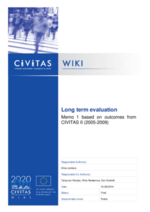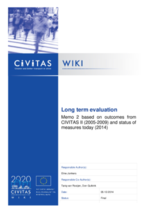Effects of CIVITAS on the long term

Read about how cities experienced their participation in CIVITAS II, what goals they achieved by participating, and what the current status of the measures is.
After more than ten years of CIVITAS, the CIVITAS WIKI project seeks to explore its long term effects. To what extent did CIVITAS 'push' cities in the direction of sustainable mobility? Has CIVITAS helped cities to introduce transport measures and policies towards sustainable urban mobility? What did the cities learn from CIVITAS and how do they use these lessons? How many of the measures implemented in CIVITAS projects are still existing? The long term evaluation that is carried out in CIVITAS WIKI focuses on CIVITAS II, which took place from 2005 until 2009. During CIVITAS II, over two hundred measures were implemented and evaluated in seventeen cities.
As an intermediate result of the long term evaluation two memos have been produced. The first memo gives insight in the way in which cities experienced their participation in CIVITAS II, and what goals they achieved by participating. The memo describes the reactions from CIVITAS II cities looking back: why did they participate in CIVITAS II, what are the most beneficial outcomes, what are the lessons learned, etc. The second memo describes the current status of the measures and relates this to the status at the end of CIVITAS II, gives insight in drivers and barriers of (success of) implementation and selects cities for an in-depth analysis.
The next step in the long term evaluation is to carry out in-depth analyses. During city visits data (qualitative and possibly quantitative) will be gathered, e.g. by interviewing experts and organizing discussions. The analysis will identify which measures and cities were most successful on the longer term, and what circumstances made them successful.
Author: Eline Jonkers








